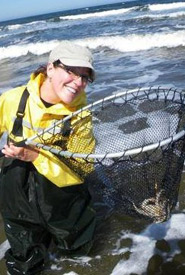Getting my hands dirty for conservation
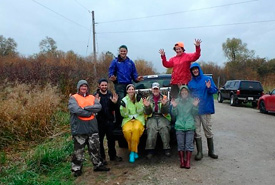
Volunteers got their hands dirty for conservation (Photo by NCC)
I started volunteering with the Nature Conservancy of Canada (NCC) about a year and a half ago, after becoming overwhelmingly “itchy” at my office job. I had been working in the environmental field for the past 20 years but was, for the most part, tied to my desk writing reports that could easily send an insomniac into a nice deep slumber. I could no longer ignore the need to get my hands dirty and positively impact my local environment in a physical, tangible way. I also love being outdoors in all four seasons and exploring the beautiful area of Ontario’s Niagara Escarpment, which I call home.
So, after years of only thinking about volunteering, I finally registered for my first NCC tree planting event in the spring of 2015, and I haven’t stopped volunteering since. I thought I’d share my most recent NCC volunteer experience, with the hope that it may inspire others to jump in, help out and reap the many benefits.
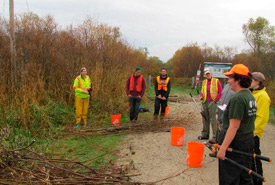
Learning how to cut live stakes (Photo by Lisa Guthrie)
It was a brisk fall day and the weather forecast was not looking good: relatively cool with an almost 100 per cent chance of getting rained on all day. As I was packing up my rain gear, winter hat and many woolly layers, I have to admit I thought: “It’s a perfect day to spend on the couch with the dog, binge-watching Netflix.” However, as with every other NCC volunteer event I’ve participated in, by the end of the day I was happy I had kicked my own butt out the door.
The project on this particular day was a live stake harvest at the Minesing Wetlands, about a 30-minute drive southeast of Collingwood, Ontario, my lovely hometown. This area is one of the largest and most undisturbed wetlands in southern Ontario, spanning an area of more than 15,000 acres (6,000 hectares). It is listed as a provincially and internationally significant wetland, and is home to more than 400 species of plants, 200 species of birds, and a diversity of other land-based and aquatic wildlife. I’ve been lucky enough to canoe, walk, explore and “work” in a few areas of this magnificent wetland. In fact, it was volunteering with NCC that led me to getting to know the Minesing Wetlands, instead of just driving by on my commute, thinking, “I’ve got to check this out sometime.”
The live stake harvesting event was hosted and coordinated by NCC and the Nottawasaga Valley Conservation Authority (NVCA), another group for which I routinely volunteer.
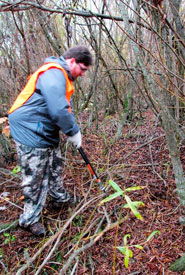
Volunteers cut braches into live stakes for replanting (Photo by Lisa Guthrie)
When I arrived on site, the other volunteers and I were greeted by three enthusiastic conservation staff members from NCC and NVCA. I’ve met and worked with these wonderful ladies at previous volunteer events; they have an obvious passion for their work, and especially for the Minesing Wetlands. Each is a wealth of knowledge, and they always take the time to answer my million questions. Their infectious energy and good humour always make the events fun — even in the rain!
Though I had planted live stakes in the Minesing Wetlands the previous spring, I had never harvested them, so I was interested in this part of the process. Using freshly sharpened pruners, we were to cut and gather branches of a certain thickness from the swamp thickets. I learned that branches from the red-osier dogwood and various shrub willow species were selected for live stake harvesting because of the presence of a hormone in the plants that allows the cut branches to form roots when buried. And not to worry — we were cautious in how many branches we removed from each “clump” to ensure the area is unaffected by our harvesting and recovers quite easily and quickly.
We worked for a few hours, cutting and dragging bundles of branches out of the thickets. Miraculously, the rain held off and it even warmed up enough to remove a layer of clothes. I certainly didn’t expect to sweat that day so I was pleasantly surprised! Once we gathered enough branches, we began cutting them into lengths, or live stakes. Cutting the live stakes went relatively quickly and provided an opportunity for us to gather and chit-chat and get to know each other better. I learned that the live stakes we were harvesting would be planted by volunteers (like me!) in the streambanks of the Mad River as part of a project to restore the natural flow of the river. The live stakes will prevent erosion of the streambanks, provide stabilization, food and habitat for species, and eventually add shade to cool the waterway. Interesting to know: successful live stake plantings are just as effective at reducing erosion as rock and concrete.
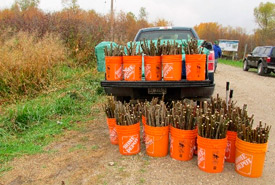
Live stakes for replanting (Photo by Lisa Guthrie)
Luckily, the rain held off until about 30 minutes before we finished cutting the last few branches. Despite the light rain, our spirits remained high, especially when we realized we would meet our goal of filling all 20 buckets with live stakes an hour early! It was incredibly satisfying to see the buckets of approximately 2,000 live stakes being loaded up and readied for their journey to the NVCA cooler for their month-long nap.
This volunteer event was fun, informative and incredibly gratifying, just like every other volunteer event in which I’ve participated. In addition to harvesting live stakes, I’ve planted trees in some gorgeous locations, donned hip waders to help stabilize streambanks, planted native beach grasses for dune restoration, relieved stress through removing invasive species and enjoyed the beach while guarding endangered piping plovers.
Volunteering has been immensely satisfying. At the end of the day, seeing tangible results of the work I’ve done to help the environment I love is soul enriching! I highly recommend volunteering — you won’t regret it!

